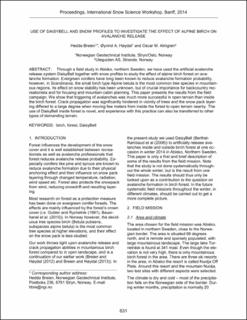| dc.contributor.author | Breien, Hedda | |
| dc.contributor.author | Høydal, Øyvind A. | |
| dc.contributor.author | Almgren, Oscar M. | |
| dc.date.accessioned | 2023-08-10T08:09:01Z | |
| dc.date.available | 2023-08-10T08:09:01Z | |
| dc.date.issued | 2014 | |
| dc.identifier.uri | https://hdl.handle.net/11250/3083288 | |
| dc.description.abstract | Through a field study in Abisko, northern Sweden, we have used the artificial avalanche release system DaisyBell together with snow profiles to study the effect of alpine birch forest on avalanche formation. Evergreen conifers have long been known to reduce avalanche formation probability, however, in Scandinavia, the small birch type Alpine betula is the most common tree species in mountainous regions. Its effect on snow stability has been unknown, but of crucial importance for backcountry recreationists and for housing and mountain cabin planning. This paper presents the results from the field campaign. We show that triggering of avalanches was much more successful in open terrain than inside the birch forest. Crack propagation was significantly hindered in vicinity of trees and the snow pack layering differed to a large degree when moving few meters from inside the forest to open terrain nearby. The use of DaisyBell inside forest is novel, and experience with this practice can also be transferred to other types of demanding terrain. | en_US |
| dc.language.iso | eng | en_US |
| dc.publisher | Montana State University Library | en_US |
| dc.relation.ispartofseries | The International Snow Science Workshop (ISSW) Proceedings; | |
| dc.subject | Avalanche-RnD | en_US |
| dc.subject | Snøskred-FoU | en_US |
| dc.title | Use of Daisybell and Snow Profiles to Investigate the Effect of Alpine Birch on Avalanche Release | en_US |
| dc.type | Chapter | en_US |
| dc.source.pagenumber | 4 | en_US |
| dc.identifier.doi | https://arc.lib.montana.edu/snow-science/item/2125 | |
